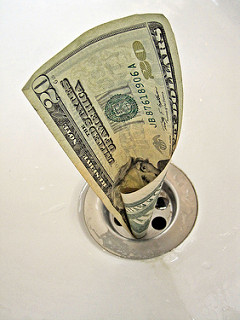There are a ton of little ways you could be wasting money (some even every day) and you might not even realize it! I’d like to think I’ve done a great job of kicking my savings gear into overdrive this past year in order to get ready for baby. Having kids obviously changes things, and I’ve been thinking more about how I can add to my savings without sacrificing too much of my monthly budget. I already allocate for an emergency savings account, as well as other important savings goals (vacation, home upgrades, etc.), but I wanted to find more ways to add to those little piles of cash, even if it was only a few extra bucks per month. I’ve been looking at the items I budget for to see if I can trim any corners, and I wanted to share some of them with you. Some of them are probably no-brainers that we’ve talked about a million times before here, but some of them might be things that never occurred to you before. Do any of them apply to your spending, and can cutting back or getting rid of them help to grown your own savings account?
Bottled water – This can get pricey, especially if you’re buying bottles on the go, which can cost at least $2 a piece. Opt for a refillable plastic bottle that you can wash and reuse, or if you MUST, buy water by the case and bring it with you when you head out (in which cases, you average about 50 cents or less per bottle). AVERAGE SAVINGS = $25 – $50 PER MONTH
Stopping for morning coffee – I’m not a coffee drinker, but I’m a sucker for fresh-pressed juices and smoothies in the morning, and this falls in the same kind of category. Invest in ways to prep what you love at home instead of stopping on your way into work. A quick Google search might even pull up recipes for some of your favorite drinks. You’ll save both time AND money by passing on this. AVERAGE SAVINGS = $5 TO $15 PER WEEK
Name brands – If you can’t tell from former posts, I can’t stress enough how much you can save by switching to generic or store brands instead of buy name-brand products, including everything from food to cleaning products. If you’re really not convinced, you can even compare ingredient lists for further evidence. AVERAGE SAVINGS WILL VARY BY ITEM
Eating out – The average cost to eat lunch or dinner out is about $9 – $15 per person. For about the same price, you can buy fresh ingredients at your local grocery store that allow you to make multiple meals that you can pack and bring to work with you. You’ll save more AND be healthier at the same time. AVERAGE SAVINGS = $5 – $10 PER MEAL
Premium gas – I’ve actually never bought premium gas over the regular-priced version, but I’m assuming people out there do, since it’s still an option at the pump. This was generally recommended for high-end or turbocharged vehicles (and in some cases, required, as mentioned in some vehicle user manuals), but new technology and development that we have now typically compensates for the lower-grade gasoline most people put in their cars every day. AVERAGE SAVINGS = 20 CENTS – $1.50 PER GALLON
Owning DVDs – This one can vary a lot from person to person. It occurred to me while I was cleaning our living room the other day that we have a TON of DVDs that we almost never watch! Unless it’s a movie you already know you love and you plan on (and already have) watched it repeatedly, it’s not really worth the money. Rent it online or at Redbox instead. As an added bonus, consider selling some of your collection to make some of that cash back! AVERAGE SAVINGS = $20 – $75 per year
Upgrading your flight or hotel – There’s no need to get fancy, especially if minimal time will be spent on both travel duration and your stay. Stick with your basics to save as much as you can. AVERAGE SAVINGS WILL VARY
Bottle service – I obviously haven’t done much drinking lately, but this came up over a dinner conversation the other day when perusing the wine list of the restaurant we were at. Have you ever noticed that the price per bottle can differ greatly from what you might see on the liquor store shelves? The same goes for other liquors you might see out in bars or clubs. Venues overprice bottles to make a profit, sometimes tripling what you would ordinarily pay. To save more, order by the glass, or even better, find a place that’s BYOB. AVERAGE SAVINGS = $15 – $100 PER BOTTLE

